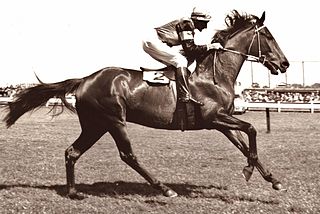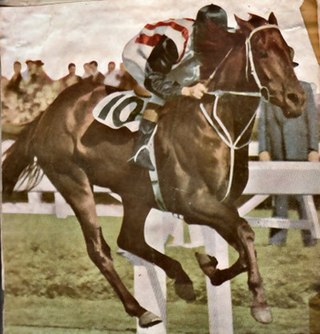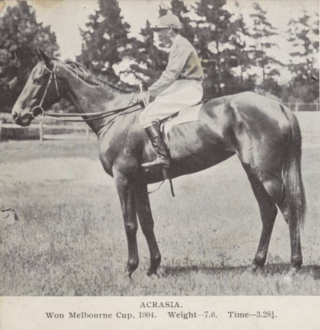
The Melbourne Cup is an annual Group 1 Thoroughbred horse race held in Melbourne, Australia, at the Flemington Racecourse. It is a 3200-metre race for three-year-olds and older, conducted by the Victoria Racing Club that forms part of the Melbourne Spring Racing Carnival. It is the richest two-mile handicap in the world and one of the richest turf races. The event starts at 3:00 pm on the first Tuesday of November and is known locally as "the race that stops the nation".

Thoroughbred horse racing is a spectator sport in Australia, and gambling on horse races is a very popular pastime with A$14.3 billion wagered in 2009/10 with bookmakers and the Totalisator Agency Board (TAB). The two forms of Thoroughbred horseracing in Australia are flat racing, and races over fences or hurdles in Victoria and South Australia. Thoroughbred racing is the third most attended spectator sport in Australia, behind Australian rules football and rugby league, with almost two million admissions to 360 registered racecourses throughout Australia in 2009/10. Horseracing commenced soon after European settlement, and is now well-appointed with automatic totalizators, starting gates and photo finish cameras on nearly all Australian racecourses.

The Caulfield Cup is a Melbourne Racing Club Group 1 Thoroughbred horse race held under handicap conditions. This is for all horses aged three years old and older. It takes place over a distance of 2400 metres at the Caulfield Racecourse, Melbourne, Australia in mid October. The prize money is A$5,000,000.
The Australian and New Zealand punting glossary explains some of the terms, jargon and slang which are commonly used and heard on Australian and New Zealand racecourses, in TABs, on radio, and in the horse racing media. Some terms are peculiar to Australia, such as references to bookmakers, but most are used in both countries.
Might and Power was a New Zealand bred, Australian owned and trained Thoroughbred racehorse who was named Australian Horse of the Year in 1998 and 1999. As a four-year-old, Might And Power won the Caulfield and Melbourne Cups, and returned at five to become only the second horse in the history of Australian racing to win both Cups and the Cox Plate. He also won a number of other weight-for-age races in this period, including the Mercedes Classic, the AJC Queen Elizabeth Stakes, and the Doomben Cup. A strong, free-striding front-runner, he broke course records in winning the Caulfield Cup, the Doomben Cup, and the Cox Plate, and won a number of races by big margins.

Rat-baiting, or better known as Rat Coursing, is a blood sport that involves releasing captured rats in an enclosed space with spectators betting on how long a dog, usually a terrier and sometimes referred to as a ratter, takes to kill the rats. Often, two dogs competed, with the winner receiving a cash prize. It is now illegal in most countries.
Gurner's Lane (1978−2000) was a Thoroughbred racehorse who was the 1983 champion. He is best remembered for winning the Caulfield and Melbourne Cups double in 1982. Gurner's Lane was just the seventh of 11 horses to complete this rare double.
John James Miller is a former champion jockey and horse trainer. Miller rode more than 2200 winners in a career which started with his first win after just six races in 1947. He rode his last race in 1988 and then went on to a successful career as a trainer. He rode winners in all Australian states as well as enjoying overseas success in England, Mauritius, Ireland and Singapore.

Etienne Livingston de Mestre, was a 19th-century Australian breeder and jockey of Thoroughbred racehorses. He was Australia's first outstanding racehorse trainer and racing identity. In his 30-year career, he experienced all the highs and the lows of the turf in a career which ended with him dependent on donations from racing friends.

Tulloch was a champion Australian Thoroughbred racehorse who was one of the greatest Australian stayers.

The Double Event is a 1911 Australian feature-length film directed by W. J. Lincoln based on the first novel by Nat Gould, which had been adapted several times for the stage, notably by Bland Holt.

Protectionist was a Thoroughbred racehorse bred and trained in Germany. He was bred by Christoph Berglar, and owned by Berglar in conjunction with an Australian syndicate. Protectionist was the winner of the 2014 Melbourne Cup, ridden by Ryan Moore and trained by Andreas Wöhler, and became the first German-trained horse to win the race.
Charles Leslie Macdonald, generally known as Leslie or C. Leslie Macdonald, was a racehorse owner and breeder, noted for two Melbourne Cup winners, Revenue in 1901 and Night Watch in 1918.
James "Old Jim" Wilson was a racehorse trainer in Victoria, Australia, founder of the historic St Albans Stud in Geelong, and trainer of the 1873 Melbourne Cup winner Don Juan and 1876 winner Briseis. His older son James Wilson, Jr. captained the Geelong Football Club and as "Young Jim Wilson" trained 1899 Cup winner Merriwee. His younger son William Wilson was the jockey who rode Don Juan to victory in the 1873 Cup.
Comedy King (1907–1929) was a British bred thoroughbred racehorse that raced his entire career in Australia. He is most notable for winning the 1910 Melbourne Cup and becoming the first Northern-Hemisphere bred horse to do so.

Winooka was a bay Australian thoroughbred stallion who raced for 5 seasons from a two-year-old to a six-year-old including America recording major wins from 6 furlongs to 1 mile and winning jockeys being Stan Davidson from Newcastle and Sydney Australian Racing Hall of Fame inductees Jim Pike and Edgar Britt.

Gothic was a black Australian thoroughbred stallion who raced for 4 seasons from a three-year-old to a six-year-old, recording major wins from 6 furlongs to 1½ miles and champion Sydney jockey Jim Pike the Australian Racing Hall of Fame inductee 2002 winning 9 races.

Acrasia was an Australian racehorse that won the 1904 Melbourne Cup.
The 1870 Melbourne Cup was a two-mile handicap horse race which took place on Thursday, 10 November 1870. This year was the tenth running of the Melbourne Cup. The entire carnival was pushed back a week due to a waterlogged track.
Solomon Green, invariably referred to as "Sol Green", was a Melbourne bookmaker and racehorse owner and breeder. He styled himself "Leviathan of the Ring" but was also referred to as "Foots" on account of the size of his "pedal extremities".










